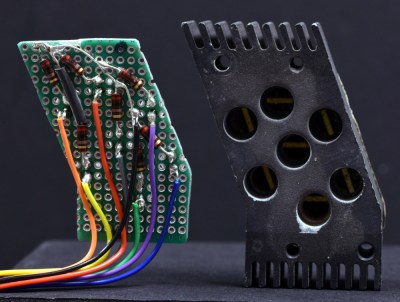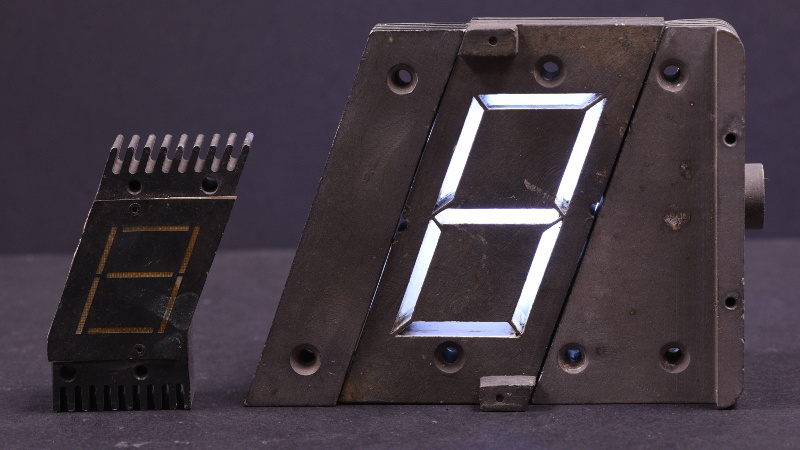When [Patrick Hickey] spent a tidy sum on eBay to purchase a pair of seven-segment displays used in the Launch Control Center at Kennedy Space Center during the Apollo program, he could have just put them up on a shelf. It’s certainly what most people would have done. Instead, he’s decided to study and document their design with the hope of eventually creating 3D replicas of these unique pieces of NASA history.
With a half century now separating us from the Moon landing, it’s more important than ever to preserve the incredible technology that NASA used during mankind’s greatest adventure. Legitimate Apollo-era hardware is fairly scarce on the open market, and certainly not cheap. As [Patrick] explains on the Hackaday.io page for this project, being able to 3D print accurate replicas of these displays is perhaps the best way we can be sure they won’t be lost to history.
 But more than that, he also wants others to be able to see them in operation and perhaps even use them in their own projects. So that means coming up with modern electronics that stand-in for the 60s era hardware which originally powered them.
But more than that, he also wants others to be able to see them in operation and perhaps even use them in their own projects. So that means coming up with modern electronics that stand-in for the 60s era hardware which originally powered them.
Since [Patrick] doesn’t have access to whatever (likely incandescent) lighting source these displays used originally, his electronics are strictly functional rather than being an attempt at a historic recreation. But we have to say, the effect looks fantastic regardless.
Currently, [Patrick] is putting most of his efforts on the smaller of the two displays that he calls “Type A”. The chunk of milled aluminum with integrated cooling fins has a relatively simple shape that should lend itself to replication through 3D scanning or even just a pair of calipers. He’s also put together a proof of concept for how he intends to light the display with 5mm LEDs on a carefully trimmed bit of protoboard, which he plans on eventually refining to reduce the number of wires used.
One aspect he’s still a little unsure of is how best to replicate the front mask. It appears to be made of etched metal with an integrated fiberglass diffuser, and while he’s already come up with a few possible ways to create a similar front panel for his 3D printed version, he’s certainly open to suggestions from the community.
This isn’t the first time we’ve seen a dedicated individual use 3D printing to recreate a rare and expensive object. While the purists will say that an extruded plastic version doesn’t compare to the real thing, we think it’s certainly better than letting technology like this fade into obscurity.
















Another instance of “3d printing ducted 7 segment displays” – https://hackaday.com/2018/03/18/this-big-bright-seven-segment-display-is-3d-printable/ – given Fran’s fascination with everything Apollo, I wouldn’t be surprised these are both trying to recreate the same module.
Translucent bits could be laser cut from acrylic, or 3d printed using petg. Or simply hand/cnc/laser cut from a bit of custom fibreglass. Or cast into the part with home-brew pla. So so many options.
Or print the face with the translucent bits missing (basically leaving holes), pause printing, fill holes with hot glue, resume printing?
That’s messy :) https://hackaday.com/2019/01/13/hot-glue-makes-these-segments-glow/
That looks like normal FR4 PCB material. Many Chinese PCB fabricators will do you a batch of 10 for around $5. Get it in 0.6 mm (or as thin as you can get) without mask. At the same time you can also order a PCB to take the LED’s (possibly go for SMD ones?)
Looks uber cool btw!
There are some aspects of the old spacecraft that I think need to be preserved for sure, but the computer and display technology is not among what I would keep. I would be much more concerned about the things we can not do better now, or have not done in a long time. The old computers and electronics are cool but really just historic curiosities.
Patrick says:
“The displays are machined from solid chunks of aluminium and have heat sink/cooling fins”.
I’d disagree and put my money on an extruded aluminium profile.
I agree. The rounded tips of the fins seems to indicate that. Heatsink manufacturers of the era would have been able to do these without too much trouble tooling up.
What about the internal details? Wouldn’t they have had to been milled out at least?
You’re right, the cavity would have to be milled out.
But looking at it in context with the larger unit and the rounded edges on the front protrusions, it looks like a casting.
Some more detailed photos would resolve it.
There’s no scale in the posted photos and no measurements are given but I suspect the incandescent lamps may be similar to what was used on computer front panels of the era.
For instance, there is this thread on the VCForum about DEC PDP-8/e minicomputer lamp replacements (which points through to another page on the bulb manufacturers and part numbers) and yes these sort of things are still available:
http://www.vcfed.org/forum/showthread.php?46078-pdp8e-light-bulbs
https://my.rs-online.com/web/p/filament-indicator-lamps/2945191/ my guess is they used these types of lamps
About the front mask. Scale modellers have been using photo etch parts for a long time, and some even make their own. Normally these are made using thin brass sheet which I think would be ideal for this display (just give it a light spray of matt black after etching).
This page details how to make your own:
https://www.britmodeller.com/forums/index.php?/topic/234944044-how-to-make-photo-etched-parts-at-home/
There may be companies out there who will do this for you, some enquiry posts on modelling forums may bring some leads.
This is crying out for a microprocessor PWMming the LEDS. Bonus points for using warm white LED’s. Also Ive been thinking about the possibility of using a dim red LED and a much brighter white LED to fake the spectrum change that incandescent lights go through during the 1/3-1/2 second warmup/cool down.
Nice idea. Warm white with pwm would do it
There are SK6812 with various temperatures of “white” in one package https://ae01.alicdn.com/kf/HTB1nsVpMXXXXXcbXXXXq6xXFXXXV/SK6812WWA-with-black-frame-SK6812-addressable-5050-SMD-LED-with-3-color-chips-built-in-warm.jpg
Called “WWA” for Cold White, Warm White, Amber. And you’re not limited to one at a atime
yeah, these (ground equipment!) displays in particular reek of “milking my government contract for all it’s worth” rather than useful innovation :-(
Ignorant comments like this are precisely why the tech should be studied. LEDs had only just been invented a few years before this system would have been built, they weren’t exactly ready for prime time.
Nobody was “milking” the government, this was peak technology of the day. Incandescent displays would have been the most economical and reliable technology available to them.
The media has been a bad influence on people’s thought process.
How is he wrong? It’s an overkill holder for seven incandescent bulbs…